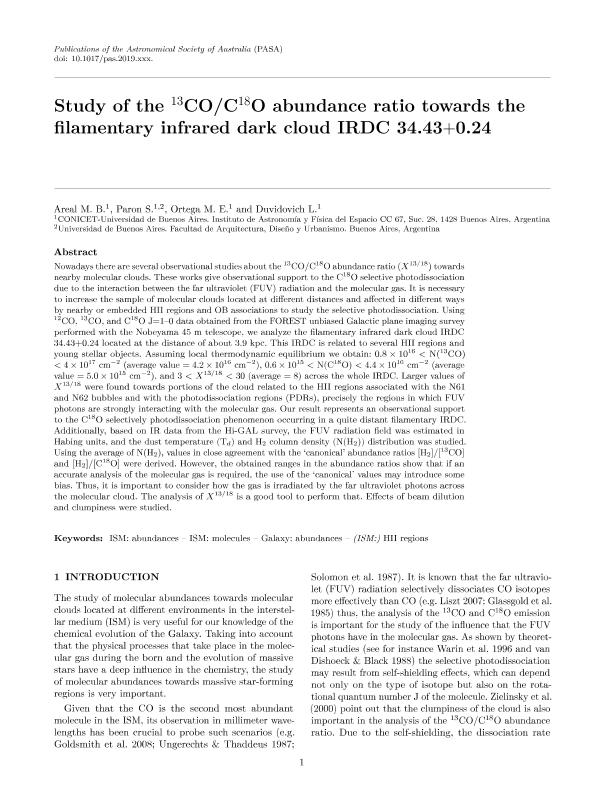Mostrar el registro sencillo del ítem
dc.contributor.author
Areal, María Belén

dc.contributor.author
Paron, Sergio Ariel

dc.contributor.author
Ortega, Martin Eduardo

dc.contributor.author
Duvidovich, Laura Patricia

dc.date.available
2022-12-22T13:29:59Z
dc.date.issued
2019-11
dc.identifier.citation
Areal, María Belén; Paron, Sergio Ariel; Ortega, Martin Eduardo; Duvidovich, Laura Patricia; Study of the 13CO/C18O abundance ratio towards the filamentary infrared dark cloud IRDC 34.43 + 0.24; Cambridge University Press; Publications Of The Astronomical Society Of Australia; 11-2019; 1-10
dc.identifier.issn
1323-3580
dc.identifier.uri
http://hdl.handle.net/11336/182152
dc.description.abstract
Nowadays, there are several observational studies about the 13CO/C18O abundance ratio ( $X^{13/18}$ ) towards nearby molecular clouds. These works give observational support to the C18O selective photodissociation due to the interaction between the far ultraviolet (FUV) radiation and the molecular gas. It is necessary to increase the sample of molecular clouds located at different distances and affected in different ways by nearby or embedded H ii regions and OB associations to study the selective photodissociation. Using 12CO, 13CO, and C18O J = 1-0 data obtained from the FOREST unbiased Galactic plane imaging survey performed with the Nobeyama 45-m telescope, we analyse the filamentary infrared dark cloud IRDC $34.43+0.24$ located at the distance of about 3.9 kpc. This infrared dark cloud (IRDC) is related to several H ii regions and young stellar objects. Assuming local thermodynamic equilibrium, we obtain: $0.8 imes 10^{16} <$ N(13CO) $<4 imes 10^{17}$ cm-2 (average value $= 4.2 imes 1016$ cm-2), $0.6 imes 10^{15} <$ N(C18O) $<4.4 imes 10^{16}$ cm-2 (average value $= 5.0 imes 10^{15}$ cm-2), and 3 $<$ $X^{13/18}$ $<$ 30 (average $= 8$ ) across the whole IRDC. Larger values of $X^{13/18}$ were found towards portions of the cloud related to the H ii regions associated with the N61 and N62 bubbles and with the photodissociation regions, precisely the regions in which FUV photons are strongly interacting with the molecular gas. Our result represents an observational support to the C18O selectively photodissociation phenomenon occurring in a quite distant filamentary IRDC. Additionally, based on IR data from the Hi-GAL survey, the FUV radiation field was estimated in Habing units, and the dust temperature (T ${dust}$ ) and H2 column density (N(H2)) distribution were studied. Using the average of N(H2), values in close agreement with the 'canonical' abundance ratios [H2]/[13CO] and [H2]/[C18O] were derived. However, the obtained ranges in the abundance ratios show that if an accurate analysis of the molecular gas is required, the use of the 'canonical' values may introduce some bias. Thus, it is important to consider how the gas is irradiated by the FUV photons across the molecular cloud. The analysis of $X^{13/18}$ is a good tool to perform that. Effects of beam dilution and clumpiness were studied.
dc.format
application/pdf
dc.language.iso
eng
dc.publisher
Cambridge University Press

dc.rights
info:eu-repo/semantics/openAccess
dc.rights.uri
https://creativecommons.org/licenses/by-nc-sa/2.5/ar/
dc.subject
(ISM:) H II REGIONS
dc.subject
GALAXY: ABUNDANCES
dc.subject
ISM: ABUNDANCES
dc.subject
ISM: MOLECULES
dc.subject.classification
Astronomía

dc.subject.classification
Ciencias Físicas

dc.subject.classification
CIENCIAS NATURALES Y EXACTAS

dc.title
Study of the 13CO/C18O abundance ratio towards the filamentary infrared dark cloud IRDC 34.43 + 0.24
dc.type
info:eu-repo/semantics/article
dc.type
info:ar-repo/semantics/artículo
dc.type
info:eu-repo/semantics/publishedVersion
dc.date.updated
2020-11-18T17:26:44Z
dc.journal.pagination
1-10
dc.journal.pais
Reino Unido

dc.description.fil
Fil: Areal, María Belén. Consejo Nacional de Investigaciones Científicas y Técnicas. Oficina de Coordinación Administrativa Ciudad Universitaria. Instituto de Astronomía y Física del Espacio. - Universidad de Buenos Aires. Facultad de Ciencias Exactas y Naturales. Instituto de Astronomía y Física del Espacio; Argentina
dc.description.fil
Fil: Paron, Sergio Ariel. Consejo Nacional de Investigaciones Científicas y Técnicas. Oficina de Coordinación Administrativa Ciudad Universitaria. Instituto de Astronomía y Física del Espacio. - Universidad de Buenos Aires. Facultad de Ciencias Exactas y Naturales. Instituto de Astronomía y Física del Espacio; Argentina
dc.description.fil
Fil: Ortega, Martin Eduardo. Consejo Nacional de Investigaciones Científicas y Técnicas. Oficina de Coordinación Administrativa Ciudad Universitaria. Instituto de Astronomía y Física del Espacio. - Universidad de Buenos Aires. Facultad de Ciencias Exactas y Naturales. Instituto de Astronomía y Física del Espacio; Argentina
dc.description.fil
Fil: Duvidovich, Laura Patricia. Consejo Nacional de Investigaciones Científicas y Técnicas. Oficina de Coordinación Administrativa Ciudad Universitaria. Instituto de Astronomía y Física del Espacio. - Universidad de Buenos Aires. Facultad de Ciencias Exactas y Naturales. Instituto de Astronomía y Física del Espacio; Argentina
dc.journal.title
Publications Of The Astronomical Society Of Australia

dc.relation.alternativeid
info:eu-repo/semantics/altIdentifier/url/https://www.cambridge.org/core/product/identifier/S1323358019000444/type/journal_article
dc.relation.alternativeid
info:eu-repo/semantics/altIdentifier/doi/http://dx.doi.org/10.1017/pasa.2019.44
Archivos asociados
